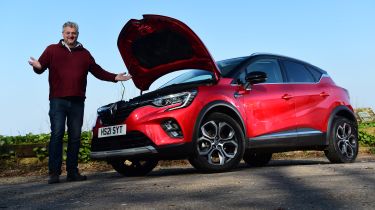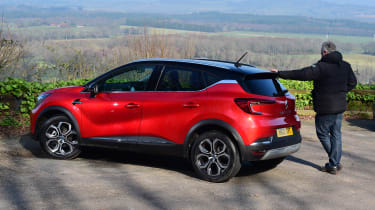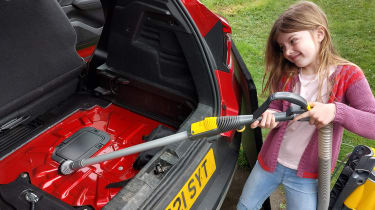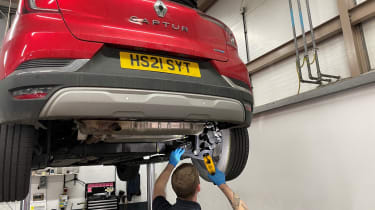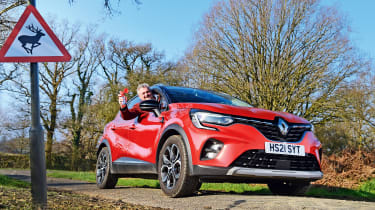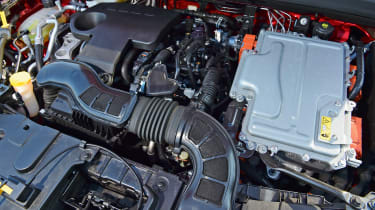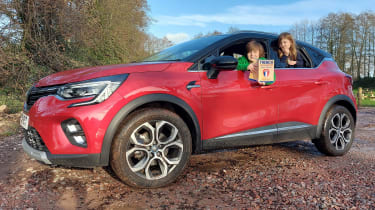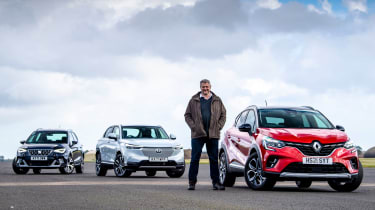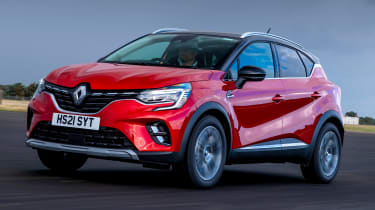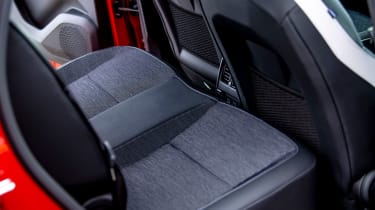Renault Captur E-Tech: long-term test review
Final report: We look back on six months with our easy-going and practical hybrid crossover

Verdict
The self-charging hybrid Captur is practical to own and comfortable to drive. It’s clean around town (and beyond) thanks to an effective all-electric mode, and we can’t fault its abilities as a family car.
- Mileage: 10,547
- Efficiency: 53.2 mpg
After six months of daily driving I’ll miss our Renault Captur hybrid, which we’ve sent home at the end of term with a very positive school report. The French car is comfortable, practical family transport, with an eager, adaptable attitude and an ability to get on well with everyone.
It’s the comfort on longer trips that has impressed me the most about the Renault, I think. After a day on your feet at a work event miles from home, the car’s easy-going nature means you can relax into that ‘clocked-off’ feeling as soon as you settle behind the wheel, not two or three hours later when you put the key in the front door. A mostly soft ride with only the occasionally jarring intrusion and a quiet cabin make it a really good long-distance cruiser.
It’s not a fun-filled driving experience, though. The light steering isn’t incisive enough for my tastes, and there’s a tendency for wallowing that deters any temptation to push on through corners. For that reason,I can’t say I’ve found the car particularly engaging, despite my appreciation for its many excellent qualities.
Used - available now

2020 Renault
Captur
18,931 milesManualPetrol1.3L
Cash £13,563
2017 Renault
Captur
61,521 milesManualPetrol0.9L
Cash £7,087
2021 Renault
Captur
45,506 milesManualPetrol1.0L
Cash £11,200
2022 Renault
Captur
4,666 milesAutomaticPetrol1.6L
Cash £16,563Another reason I haven’t really connected is that I can’t help associating the Captur’s friendly lines with supermarket car parks and the school run.
We all do those things of course, but a little more edginess about the styling and some zing to the handling would work for me. On the other hand, the Captur’s charms clearly work for many, and on a more objective level, it’s pretty hard to find fault with its practical abilities.
Indeed, while I’ve been looking for qualities the Captur was never supposed to have, our family dog has enjoyed the flexibility of a back seat that slides back and forwards depending on where the space is needed, while the only complaint from the children has been over the surprising lack of rear cup-holders.
When riding shotgun, a passenger seat with height adjustment and a decently sized touchscreen mean there’s plenty to keep the kids’ idle fingers occupied. Meanwhile, as a driver, I’ve appreciated the clear dashboard layout with straightforward rotary controls for the heating.
Also impressive is the very well modulated regenerative braking mode for the hybrid powertrain that allows one-pedal driving in almost every situation, whether that’s (almost) stop-start town traffic, or slowing downhill or at a junction.
The Captur’s full-hybrid powertrain has been a pleasure to use in all conditions, with many miles completed under electric power alone, and the smooth 1.6-litre four-cylinder petrol engine providing willing assistance as and when required, with few signs of undue strain. A recent trip to Dartmoor with a very steep hill climb caused the engine to blare intrusively and suddenly enough to wake a passenger with a start on one occasion, but in general day-to-day driving it’s been a model of decorum.
The frequent use of electric-only power means it’s been reasonably economical too, although not exceptionally so; and despite the obvious attractions I’m not really convinced that a car with an engine and a big battery is doing much to save the planet. While it might have low tailpipe emissions, the whole-life CO2 footprint could well be a different story.
Although it’s hard to quantify the cost to the planet of a hybrid Captur, the running costs have certainly been manageable. We reported in the winter that average mpg was down to the late 40s at times, but warmer spring weather boosted the economy, and when the car left us, the figure had improved to more than 53mpg.
Given the heavy reliance of the Captur’s hybrid powertrain on its electric-only mode, I’ve been wondering whether it’s simply a matter of warmer weather bringing greater battery efficiency, but it’s hard to be sure.
We just passed 10,000 miles with the car, too, which meant driving the 20-odd miles to Hendy Renault in Portsmouth for a service. It was as slick and efficient as I could have hoped for, but with no oil change – and just a new cabin air filter, plus a report on the moderate, and evenly worn condition of the tyres and brakes to show for it – I’m not sure the £124 bill seemed like great value.
Hendy even sent me a video of a technician shining a torch under the car, presumably to prove they had looked, but I would have trusted their word without it.
Renault Captur E-Tech: third report
Oh deer, what can the matter be?
- Mileage: 8,491
- Efficiency: 47.9mpg
Driving the Renault Captur for the past five months or so has been mostly very gratifying, but something that’s been bugging me almost from my first day behind the wheel suddenly jumped into sharper focus a couple of weeks ago.
That ‘something’ was a smallish roe deer, which leapt off the nearside verge at the top of Bury Hill on the A29 in West Sussex, bounced off the Captur’s bumper and barrel-rolled several times down the road.
The deer quickly sprang to its feet and skipped away to the trees on the other side of the road, closely followed by another. Hopefully the animal suffered no more than bruises and a fright, and because I was travelling significantly below the posted speed limit, the Captur’s deformable plastic bumper wasn’t damaged, either.
The thing is, I’d been expecting it. I’ve been driving the roads over and around the Sussex Downs for the best part of a decade, but until the hybrid Captur E-Tech with its ‘silent’ electric-only mode turned up, I’ve never seen so many examples of British wildlife, or in such numbers, dithering about in the roadside hedgerows and verges, looking for their moment to cross.
Could it be that the Captur’s approach is simply too stealthy when driving in battery mode, and animals typically scared away by the roar of an internal-combustion engine are being lured into danger?
To be honest, on that October evening when I first noticed the high numbers of glowing eyes reflecting the Captur’s headlights back at me from both sides of the road, I thought I was being fanciful. After all, even when in EV mode the Captur isn’t actually silent, not least because there’s the audible whistle that Renault builds in to warn of the car’s approach, but also because there’s an appreciable amount of road noise from the big tyres. But an Audi electric car engineer told me recently that you need to be travelling at somewhere close to 60mph to generate enough tyre noise to mask the sound of an internal-combustion engine.
Driving in the countryside means speeds are often lower than that, or perhaps it’s just a different noise that’s confused the animals. But following that close shave on Bury Hill, I felt the weight of evidence was sufficient to share my suspicions in a test report.
And would you believe it? Five minutes after bidding farewell to photographer Pete following the shoot for these pages, a large deer hurled itself into the road at a distance from the Captur’s bonnet that could have been measured in fag-paper widths. That heart-stopping moment was once again in EV mode… Coincidence? Who knows?
Having said all that, I find myself less inclined to go rushing about behind the wheel these days, and our Captur – with its quiet, comfortable cabin and easy driving manners, especially in regenerative braking mode, which is set-up for ‘one- pedal driving’ – encourages a relaxed driving style that suits country roads, and the wildlife, very well.
It’s equally as impressive on the motorway, with the cruise control set high enough to make decent progress, and I’m already wondering whether the Captur’s replacement – due in a few weeks – will be anything like as comfortable to live with.
Renault Captur E-Tech: second report
- Mileage: 5,410
- Economy: 47.8mpg
Pleez listen very carefully, I will say zis only once… Renault’s voice-recognition system might find work as a comedy sidekick in a BBC sitcom, but it’s proving next to useless as a driving aid.
Perhaps it’s cruel to pick out this defect in our otherwise so appealing Captur E-Tech Hybrid, but that’s the trouble with long-term tests of cars that hit the sweet spot right out of the box. If you can’t really fault the drive or practicality, an irritating detail ends up getting more column inches than perhaps it warrants. But here goes anyway!
Voice recognition from all sorts of manufacturers has been frustrating owners for a good few years now, but that was okay when it used to feel like a futuristic feature that was breaking new ground. These days, thanks to the likes of Apple, Amazon and Google assistants working so intuitively on smartphones, in-house car systems can look increasingly pointless.
The Captur struggles to recognise plain English, and telling the car where you want to go inevitably ends up with a list of proposed destinations that are hilariously wide of the mark. We only attempt it for kicks and giggles if we’re bored. Android Auto, on the other hand, is clever enough to take instructions even if you’re putting on a comedy accent to try and fool it.
My only real issue with using Google’s set-up for navigation and entertainment, instead of Renault’s own system, is that plugging in the phone adds a few moments of fiddling to every journey. The protruding cable means my phone won’t sit properly in the designated tray under the dash, either.
However, thanks to Android Auto, my relationship with the Captur is based on sound communication, and that’s great. So why bang on about it? Mostly because I dread to think how much firms like Renault have invested in their own in-house tech, and I wonder whether cars might all be a bit cheaper if companies took a more open-minded approach to sharing or buying-in. It’s encouraging to report that the system on the forthcoming new Mégane will be powered by Google and Android.
So what else is new with the Captur? We, bragged about the 53mpg-plus economy last time, but the average showing on the trip computer has since settled to 47.8mpg. That’s not quite as impressive, especially if driving a high annual mileage with the sky-high price of unleaded.
I wondered if cold weather was having an effect, but in truth I’m probably driving the Captur a bit more vigorously than in its first few weeks, because the novelty value of whirring around in full-EV mode has worn off a bit. It’s still a decently frugal figure, though, and I still get to feel smug about doing my bit for clean air on the school run.
Renault Captur E-Tech: first report
We sound out the hybrid version of the Renault Captur crossover as it joins our fleet
- Mileage: 1,153
- Economy: 53.4mpg
Passengers have described them as whooshes, whistles or whirrs, but regardless of what name you give them, I’ve become quite fond of the range of little noises that our new Renault Captur E-Tech makes while it’s in electric-only mode.
The crossover has just joined our fleet – marking its debut by beating the Honda HR-V and SEAT Arona in an Auto Express group test – and is the latest generation of self-charging hybrid. Although you don’t get the 30-odd miles of pure-electric driving that the pricier plug-in hybrid variant provides, you do spend more time under only battery power than might be imagined.
It’s not just in town where the Captur cuts out the carbon tailpipe emissions, either, because the drivetrain spends a gratifyingly large amount of time in EV mode when you’re out on the open road.
Progress at such times is marked by the aforementioned soft whistles and gentle whirrs. These are meant to warn pedestrians of what might otherwise be too stealthy an approach, but in fact help to give the Captur a little bit of personality as well as keeping the driver engaged with what it’s doing.
They’re the sort of non-intrusive but reassuring background noises you might expect from a retro-futuristic household robot politely doing its chores in a sci-fi movie, although you’ll be relieved to hear that I’ve not been tempted to give the Renault a pet name, and nor has it shown any signs of wishing to plot against me.
You can talk to the Captur, of course – at least in theory – but the early signs are that it prefers to warble quietly to itself, rather than take any notice of instructions issued to the onboard voice-recognition system.
As a parent, I’m used to that sort of behaviour, so am initially adopting a patient approach. If it continues, I’ll probably get a bit fed up, but the Captur is behaving so well in all other respects that picking fault at this early stage seems churlish. Perhaps we just need to get to know one another a little better. I’ll keep you updated.
I’ve already driven around 1,000 miles in the Captur since it was delivered, and it’s not only the sound effects that have proved endearing. For starters, I think this latest Captur is much nicer to look at than its predecessor, and the design not as, er… grandma-focused.
So although I’m not about to suggest that this baby crossover is the epitome of red-blooded machismo, our car’s combination of crisply cut 18-inch alloy wheels, metallic paint and black roof has drawn appreciative comments from at least a couple of chaps whose remarks might have been more derisory.
I like how it looks, too, and so do the kids, who have also been fascinated by the Captur’s alternating drive modes – especially when that means using grubby fingers to select Eco driving via the touchscreen. They also enjoy the raised ride height, and a recent visit to our local banger track even gave them a chance to try out tailgate spectating, although the practical boot more often plays host to a Large Munsterlander dog.
The other drive mode options are Sport and a configurable one called My Sense, neither of which I’ve yet really explored, but that’s really an indication of how nicely the Captur drivetrain works when left to its own devices. It’s smooth, quiet, sufficiently powerful when you need it, and perhaps most of all, it’s impressively efficient. My typical mix of urban, countryside and A-road miles has seen the trip computer refuse to budge from a worst-case scenario of 52.5mpg, and it more often lingers around the 54.4mpg mark. They’re the sort of numbers that, not so long ago, you’d have been gloating over from a diesel.
While low running costs are great, I’m not entirely convinced that driving a hybrid is an entirely believable environmental solution. I’m all in favour of cutting down on particulates and CO2 emissions while driving, but the lifetime carbon footprint of a car with both a traditional petrol engine and a sizeable battery is harder to fathom. If you listen harder, perhaps the Captur’s whistle has a nonchalant air.
| Model: | Renault Captur S Edition E-Tech Hybrid 145 Auto |
| On fleet since: | October 2021 |
| Price new: | £26,000 |
| Engine: | 1.6-litre 4cyl MHEV petrol |
| CO2/tax: | 114g/km/£170 |
| Options: | Metallic paint (£700) |
| Insurance*: | Group: 13 Quote: £453 |
| Mileage: | 10,547 |
| Economy: | 53.2mpg |
| Any problems? | None so far |
*Insurance quote from AA (0800 107 0680) for a 42-year-old in Banbury, Oxon, with three points.

